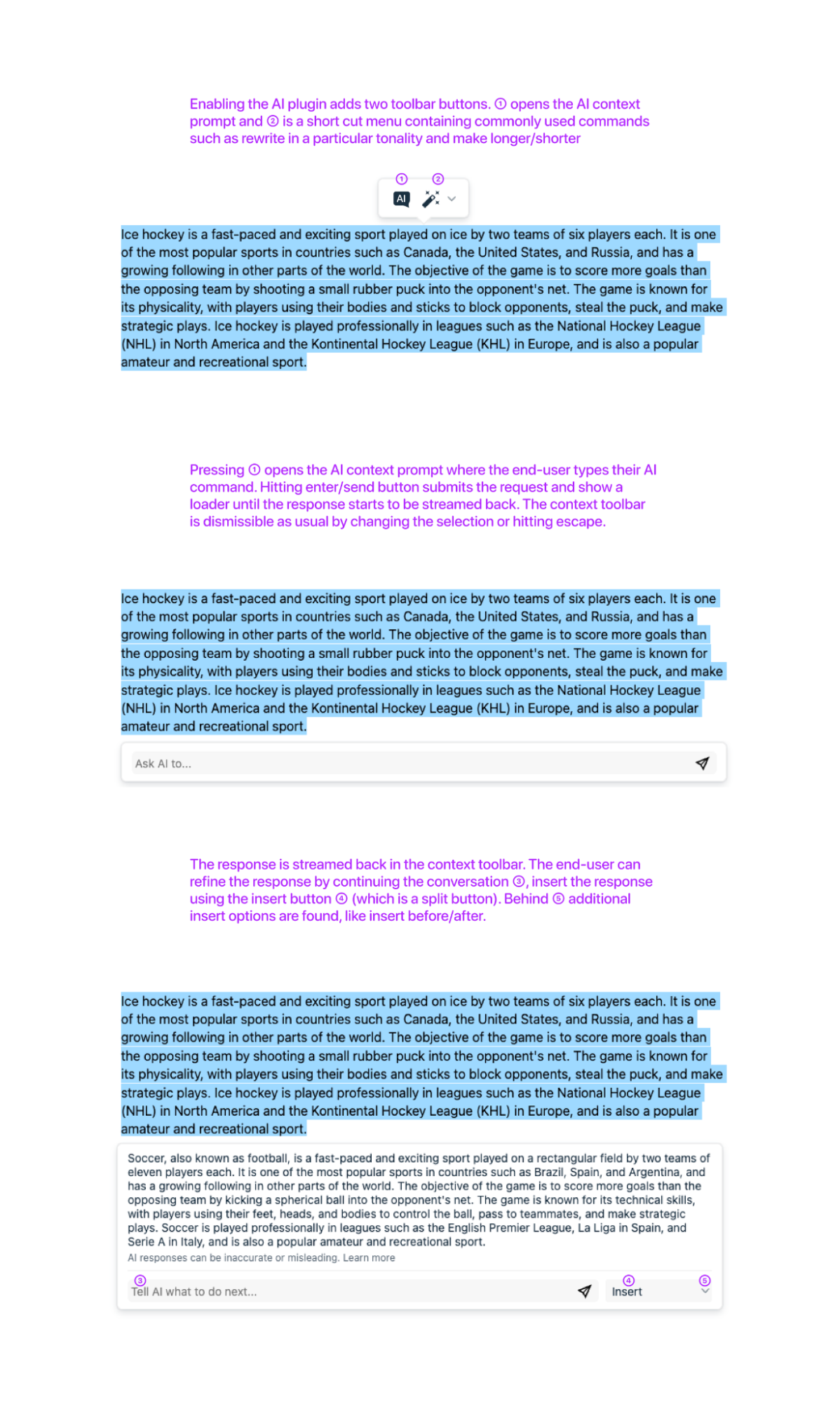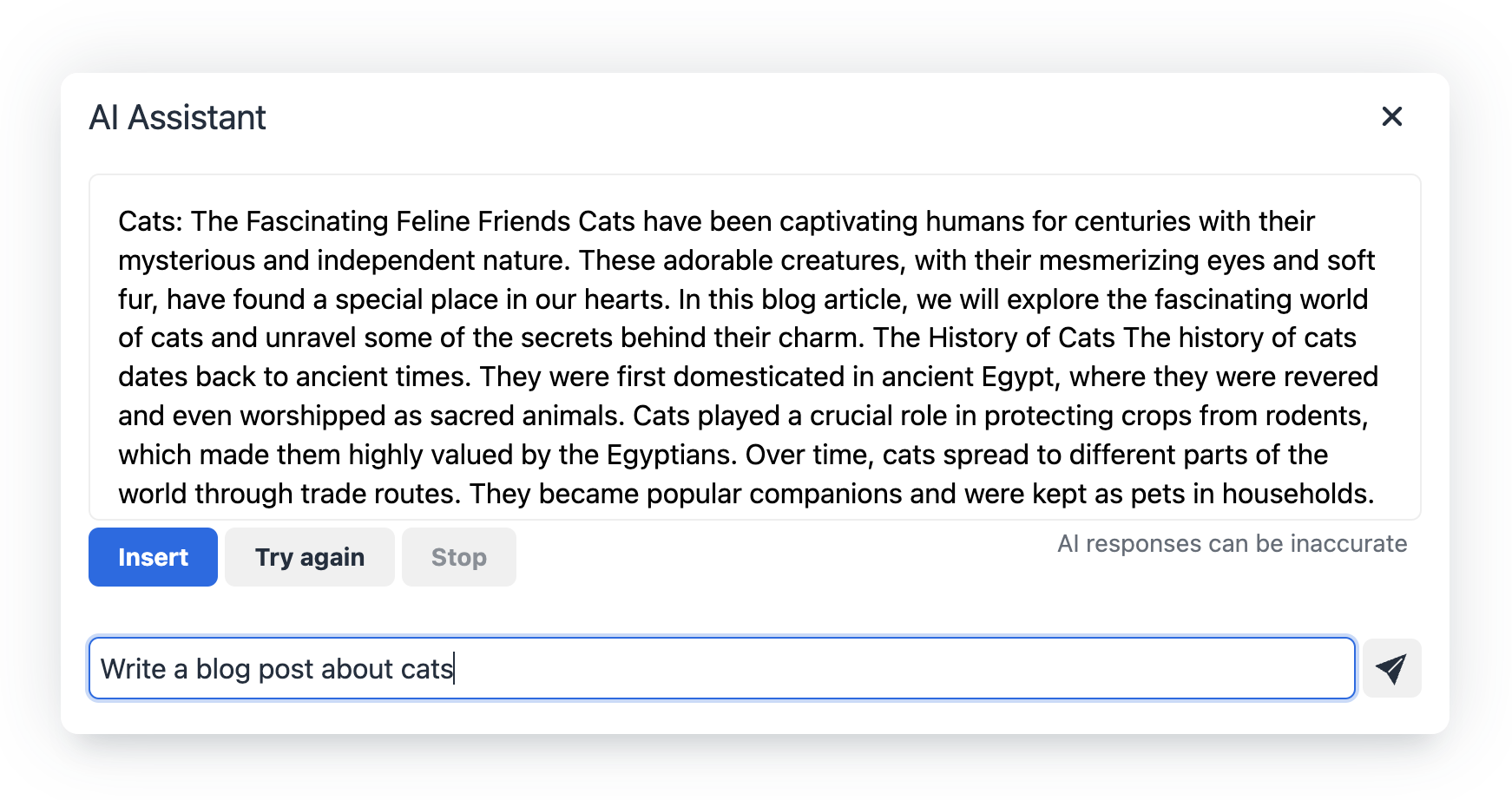With 64% of VC-backed companies planning to add generative AI to their products this year, and experts predicting that within the next few years, 50 to 90% of online content will be generated by AI or AI-assisted systems, integrating AI into your content creation app is no longer a fad. It's a necessity.
But simply adding AI to your app isn’t enough. You need to make it useful. Our top tips to make generative AI useful for your users, are based on our recent experience in researching, designing and building TinyMCE’s rich text editor AI Assistant plugin (the first to hit the market, by the way 😏).
Three weeks post-launch, the plugin has been installed over 1,000 times and loaded in over 200,000 editing sessions. It’s still early days, but we’re eager to share our learnings so you too, can add useful, generative AI to your app.
6 best practices for using generative AI in content creation apps
1. Start by focusing on your non-AI users
It's tempting to just mimic ChatGPT's capabilities. But don't forget about users who:
- Feel threatened by AI
- Have tried it and weren't satisfied
- Haven't had a chance to use it yet
By considering this broader group early on in your journey, you’ll maximize adoption and engagement.
It’s important to focus on crafting AI features not just for power users, but also for hesitant users and beginners. That way, when you turn on the capability, it adds value for everyone using your app – not just early AI adopters.
Prioritizing your non-AI audience also sets up your app for wider usage, makes AI more approachable overall and the compounding effect makes your app more valuable.

2. Make it a natural part of the content creation process
Don't treat AI as an afterthought or bolt-on feature. Bake it right into your core user experience and content creation workflows.
Start by understanding exactly how your users create content and then adapt your AI features and UI design to align perfectly with their needs.
Token limits
For example, your app’s UX design and choice of AI model should align with the specific type of content your users are creating. Recognize the differences between short-form and long-form content and adapt your app’s AI features accordingly.
For longer-form content, consider workarounds like content splitting and summarization, choose a model that has a larger token limit, or provide clear guidelines to users on how to use AI with long-form content.
User interface
By seamlessly integrating AI into the editor where they create content, it keeps users engaged in one place – rather than forcing them to toggle between tabs or abandon the AI feature.
At TinyMCE, we took time to refine our plugin UI through multiple iterations and user tests. The goal was integrating AI in a way that didn't disrupt our millions of existing users' workflow. We explored a separate "content creation chatbot" before realizing that it would be too disjointed. Instead, we focused on perfecting an integrated editor experience.
Below are some of the design iterations we worked through before finally landing on what the plugin is today:

AI Assistant design iterations and today's AI Assistant
As you can see, the UI can evolve as you learn more about users and test your assumptions.
3. Include pre-written prompts for ease of use
According to Jakob Nielsen of Nielsen Norman Group, around 80% of U.S. adults lack the skills to write effective AI prompts. Our own research tells a similar story – when we spoke to our community about AI in content creation, ease of use and making it accessible to their entire user base was the top priority.
This led us to create the ability to add pre-written prompts, so users can use AI capabilities without having to write their own. These prompts can be tailored to each company’s specific use case.
Our best advice is to NOT assume that your users know where to start, when first using AI. The inclusion of inbuilt pre-written, and/or use case-specific prompts equalizes the playing field and lets them utilize AI with just one click.
That said, advanced users may want more customization. To find the right balance between first-time and power users,, consider also providing (in addition to pre-written prompts) the option to write custom ones. That way, you’re catering to both needs and encouraging deeper usage across a broader base of people.

TinyMCE AI Assistant’s customizable pre-written prompts, enabling users to leverage generative AI without writing any prompts
4. Invest in prompt engineering and perform regular quality audits
To ensure the highest quality output from your generative AI system, invest significant time in prompt engineering and quality assurance. Experiment with different prompt formats, adjust inputs, and refine your prompts until you achieve what users expect.
But even after implementing generative AI in your app, don't assume everything will work perfectly.
Perform regular audits to identify any issues that arise, and actively seek user feedback. Consider monitoring user inputs and AI outputs through logging, or incorporate real-time feedback mechanisms such as thumbs-up/down buttons, so you can continuously optimize your prompts (and their usefulness).
When we built TinyMCE’s AI Assistant, trying to figure out how to make prompts work effectively (just like everyone else in 2023), was certainly a humbling experience. We were faced with two unexpected challenges:
I. Response formatting
The first challenge was when we had the plugin set up, went to test it, and quickly realized the default response back from OpenAI is plain text, which is not what the users of a rich text editor are expecting:

Initial version of AI Assistant without HTML formatting
With some quick and creative prompt engineering, our team was able to get OpenAI to return content in compliant HTML format, a perfect fit for our HTML-based editor:

With HTML formatting. That’s better!
II. Usable prompts
The second, bigger challenge was to come up with the useful default prompts that ship with Tiny’s AI Assistant. Although this work is never finished, we’re still surprised, even after much prompt engineering, at some of the responses OpenAI comes back with 🤪.

(insert facepalm emoji)
5. Quell hesitations with transparency
When using AI for content creation, it's essential to prioritize user privacy and security. Ensure that any sensitive data handled by AI is handled securely and in compliance with relevant regulations.
By reassuring users and explaining how their information is used, whether that be within your own model or a third party model, you’ll build trust and encourage adoption – especially amongst the more hesitant users.
It's also essential to educate and set realistic expectations for your users. Generative AI is still in its early stages of development, so you need to be clear that AI-generated content may not always be perfect, and patience is required. By managing user expectations, you can prevent frustration and disappointment, which usually ensures a far more positive user experience.
This reassurance can be done by incorporating suitable language into your Terms of Use and Privacy Policy, but also being more upfront through in-app messaging or in the app’s documentation.

Example of including a disclaimer inside your app’s AI UI
6. Put safeguards in place
Even if you provide clear guidelines to users that outlines what the content they generate should and shouldn’t be used for, and the types of content they shouldn’t input, the reality is that most users don’t read instructions.
There’ll always be instances where users submit restricted content, for example trade secrets, intellectual property or confidential customer information. If this is a concern in your industry, implement safeguards to prevent unwanted content from being generated or shared.
For example, you could build functionality into your app that checks for blacklisted keywords or text patterns that shouldn’t be used with AI, before anything is sent. This could be done by using a server-side proxy, which filters and manages the secure connection between your rich text editor and your LLM.
Bonus tip: Monetize your new AI feature
Consider tracking AI usage per account and incorporating it into your app’s billing model. With studies showing improvements of up to 40% decreases in writing time, and the majority of business leaders expecting generative AI to deliver transformational change at their companies within 2 years, the business value of generative AI is undebatable.
Your customers are counting on it, and are willing to pay for it. By monetizing your new AI capability, you’ll be able to fund further development of AI within your app, and consequently deliver more and more business value to your customers. It’s a win-win.
What’s next
The potential of generative AI for content creation is vast, and in these early days we’re just scratching the surface – what AI looks like one year from now will be very different than it does today. Embracing this future is an opportunity to revolutionize content creation and take it to new heights.
By following these best practices, you can harness the power of generative AI in your content creation app, without making many of the mistakes others have made. Remember, the goal is not just to add AI but to make it useful. By focusing on your users and remaining transparent about what’s going on behind-the-scenes, you’ll be empowering them in ways like never before.
